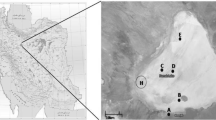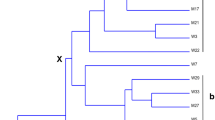Abstract
Aerobic, alkaliphilic bacteria were isolated and characterized from water and sediment samples collected in the winter season, January 2002 from alkaline Lonar lake, India, having pH 10.5. The total number of microorganisms in the sediment and water samples was found to be 102–106 cfu g−1 and 102–104 cfu ml−1, respectively. One hundred and ninety-six strains were isolated using different enrichment media. To study the bacterial diversity of Lonar lake and to select the bacterial strains for further characterization, screening was done on the basis of pH and salt tolerance of the isolates. Sixty-four isolates were subjected to phenotypic, biochemical characterization and 16S rRNA sequencing. Out of 64, 31 bacterial isolates were selected on the basis of their enzyme profile and further subjected to phylogenetic analysis. Phylogenetic analysis indicated that most of the Lonar lake isolates were related to the phylum Firmicutes, containing Low G+C, Gram-positive bacteria, with different genera: Bacillus, Paenibacillus, Alkalibacillus, Exiguobacterium, Planococcus, Enterococcus and Vagococcus. Seven strains constituted a Gram-negative bacterial group, with different genera: Halomonas, Stenotrophomonas and Providencia affiliated to γ-Proteobacteria, Alcaligenes to β-Proteobacteria and Paracoccus to α-Proteobacteria. Only five isolates were High G+C, Gram-positive bacteria associated with phylum Actinobacteria, with various genera: Cellulosimicrobium, Dietzia, Arthrobacter and Micrococcus. Despite the alkaline pH of the Lonar lake, most of the strains were alkalitolerant and only two strains were obligate alkaliphilic. Most of the isolates produced biotechnologically important enzymes at alkaline pH, while only two isolates (ARI 351 and ARI 341) showed the presence of polyhydroxyalkcanoate (PHA) and exopolysaccharide (EPS), respectively.


Similar content being viewed by others
References
Altschul SF, Madden TL, Schaffer AA, Zhang J, Zhang Z, Miller W, Lipman OJ (1997) Gapped BLAST and PSI-BLAST: a new generation of protein database search programs. Nucleic Acids Res 25:3389–3402
Ausubel FM, Brent R, Kingston RE, Moore DD, Seidman JG, Smith JA, Struhl K (2002) The Polymerase Chain Reaction. In: Short Protocols in Molecular Biology, 5th Edn., Vol. II, Wiley, New York
Badve RM, Kumaran KPN, Rajshekhar C (1993) Eutrophication of Lonar lake, Maharashtra. Curr Sci 65:347–351
Borsodi AK, Micsinai A, Rusznyak A, Vladar P, Kovacs G, Toth EM, Marialigeti K (2005) Diversity of alkaliphilic and alkalitolerant bacteria cultivated from decomposing reed rhizomes in a Hungarian soda lake. Microb Ecol 50:9–18
Boyer EW, Ingale MB, Mercer GD (1973) Bacillus alcalophilus subsp. halodurans subsp. nov.: an alkaline-amylase producing alkalophilic organism. Int J Syst Bacteriol 23:238–242
Chaphalakar S, Dey S (1994) Some aspects of production of extracellular protease from Streptomyces diastaticus. J Micro Biotechnol 9:85–100
Collins MD, Lund BM, Farrow JAE, Schleifer KH (1983) Chemotaxonomic study of an alkalophilic bacterium, Exiguobacterium aurantiacum gen nov., sp. nov. J Gen Microbiol 129:2037–2042
Cruickshank R, Duguid JP, Swain RPA (1965) Medical Microbiology, 11th Edn. English Language Book Society, E. and S. Livingstone, Edinburgh London
Duckworth AW, Grant WD, Jones BE, Meijer D, Marquez MC, Ventosa A (2000) Halomonas magadii sp. nov., a new member of the genus Halomonas isolated from a soda lake of East African Rift Valley. Extremophiles 4:53–60
Duckworth AW, Grant WD, Jones BE, Van SR (1996) Phylogenetic diversity of soda lake alkaliphiles. FEMS Microbiol Ecol 19:181–191
Grant WD, Jones BE, Mwatha WE (1990) Alkaliphiles: ecology, diversity and applications. FEMS Microbiol Rev 75:255–270
Grant WD, Tindall BJ (1980) The isolation of alkalophilic bacteria. In: Gould GW, Corry ICL (Eds.) Microbial Growth and Survival in Extremes of Environment. Academic Press, London, pp 27–36
Greenberg AE, Clesceri LS, Eaton AD (1992) Standard methods for the examination of water and wastewater, 18th Edn. APHA, AWWA and WPCF, Washington D.C.
Hashim SO, Delgado O, Hatti-Kaul R, Mulaa FJ, Mattiasson B (2004) Starch hydrolyzing Bacillus halodurans isolated from a Kenyan soda lake. Biotechnol Lett 26:823–828
Hickman-Brenner FW, Farmer JJ III, Steigerwalt AG, Brenner DJ (1983) Providencia rustigianii: a new species in the family Enterobacteriaceae formerly known as Providencia alcalifaciens Biogroup 3. J Clin Microbiol 7:1057–1060
Horikoshi K (1991) Isolation and classification of alkalophilic microorganisms. In: Horikoshi K (Ed.) Microorganisms in alkaline environment. Kodansha, Tokyo, VCH Verlagsgesellschaft, Weinheim and VCH Publishers, New York
Horikoshi K (1999) Alkaliphiles: Some applications of their products for biotechnology. Microbiol Mol Biol Rev 63:735–750
Humayoun SB, Bano N, Hollibaugh JT (2003) Depth distribution of microbial diversity in Mono lake, a meromictic soda lake in California. Appl Environ Microbiol 69:1030–1042
Jhingram AG, Rao KV (1954) Lonar lake and its salinity. In: Records of the Geological Survey of India, Vol. 85, pp 313–334
Jones BE, Grant WD, Duckworth AW, Owenson GG (1998) Microbial diversity of soda lakes. Extremophiles 2:191–200
Joshi AA, Kanekar PP, Sarnaik S, Kelkar A (2005) Bacterial diversity of Lonar lake ecosystem. In: Banmeru PK, Banmeru SK, Mishra VR (eds) Biodiversity of Lonar crater. Anamaya, New Delhi, pp 71–75
Kanekar PP, Sarnaik SS, Kelkar AS (1999) Bioremediation of phenol by alkaliphilic bacteria isolated from alkaline lake of Lonar, India. J Appl Microbiol (Suppl) 85:1285–1335
Krieg NR, Holt JG (1984) Bergey’s Manual of Systematic Bacteriology, Vol. I. Williams and Wilkins, Baltimore
Kumar S, Tamura K, Nei M (2004) MEGA 3: Integrated software for Molecular Evolutionary Genetics Analysis and Sequence Alignment. Brief Bioinfo 5:150–163
Lane DJ (1991) 16S/23S rRNA sequencing. In: Stackebrandt E, Goodfellow M (Eds.) Nucleic Acid Techniques in Bacterial Systematics. Wiley, Chichester
Lopez-Garica P, Kazmierczak J, Benzerara KS, Guyot F, Moreira D (2005) Bacterial diversity and carbonate precipitation in the giant microbialites from the highly alkaline lake Van, Turkey. Extremophiles 9:263–274
Ma Y, Weizhou Z, Xue Y, Zhon P, Ventosa A, Grant WD (2004) Bacterial diversity of the inner Mongolian Baer Soda lake as revealed by 16S rRNA gene sequence analysis. Extremophiles 8:45–51
Malu RA, Dhabhade DS, Kodarkar MS (2000) Diversity in Lonar lake. J Aquat Bio 15:16–18
Mancuso Nichols CA, Garon S, Bowman JP, Raguenes G, Guezennec J (2004) Production of exopolysaccharides by Antarctic marine bacterial isolates. J Appl Microbiol 96:1057–1066
Martins RF, Davids W, Abu Al-Soud W, Levander F, Radstrom P, Hatti-Kaul R (2001) Starch hydrolyzing bacteria from Ethiopian soda lakes. Extremophiles 5:135–144
Mormile MR, Romine MF, Garcia MT, Ventosa A, Bailey TJ, Peyton BM (1999) Halomonas campisalis sp. nov., denitrifying, moderately haloalkaliphilic bacterium. Syst Appl Microbiol 22:551–558
Nandy NC, Deo VB (1961) Origin of the Lonar lake and its alkalinity. J Bull TISCO 8:1–12
Ostle AG, Holt JG (1982) Nile Blue A as a fluorescent stain for poly-β-hydroxybutyrate. Appl Environ Microbiol 44:238–241
Pedersen K, Nilsson E, Arlinger J, Hallbeck L, O’Neill A (2004) Distribution, diversity and activity of microorganisms in the hyper-alkaline spring waters of Maqarin in Jordan. Extremophiles 8:151–164
Prescott LM, Harley JP, Klein DA (2005) Microbiology. In: Prescott LM, Harley JP, Klein DA (eds) Microbial Nutrition, 6th Edn., McGraw-Hill, New York, pp 104–105
Quillaguaman J, Hashim S, Bento F, Mattiasson B, Hatti Kaul R (2005) Poly(β-hydroxybutyrate) production by a moderate halophile Halomonas boliviensis LC1 using starch hydrolysate as substrate. J Appl Microbiol 99:151–157
Rees HC, Grant WD, Jones BE, Heaphy S (2003) Diversity of Kenyan soda lake alkaliphiles assessed by molecular methods. Extremophiles 8:63–71
Saitou N, Nei M (1987) The neighbour joining method a new method for reconstructing phylogenetic trees. Mol Biol Evol 4:406–425
Sambrook J, Fritsch EF, Maniatis T (1989) Molecular Cloning: a Laboratory Manual, 2nd Edn. Cold Spring Harbor, New York
Schumann P, Weiss N, Stackerbrandt E (2001) Reclassification of Cellulomonas cellulans (Stackerbrandt and Keddie 1986) as Cellulosimicrobium cellulans gen. nov., comb. Nov. Int J Syst Evol Microbiol 51:1007–1010
Shewmaker PL, Steigerwalt AG, Morey RE, Carvalho MGS, Elliott JA, Joyce K, Barrett TJ, Teixeira LM, Facklam RR (2004) Vagococcus carniphilus sp. nov., isolated from ground beef. Int J Syst Evol Microbiol 54:1505–1510
Sneath PHA, Mair NS, Sharpe ME, Holf JG (1986) Bergey’s Manual of Systematic Bacteriology, Vol. II. Williams and Wilkins, Baltimore
Spanka R, Fritze D (1993) Bacillus cohnii sp. nov., a new, obligately alkaliphilic oval spore-forming Bacillus sp. with ornithine and aspartic acid instead of diaminopimelic acid in the cell wall. Int J Syst Bacteriol 43:150–156
Thompson JD, Higgins DG, Gibson TJ (1994) CLUSTAL W: improving sensitivity of progressive multiple sequence alignments through sequence weighing, position-specific gap penalties and weight matrix choice. Nucleic Acids Res 22:4673–7680
Tiago I, Chung AP, Verissimo A (2004) Bacterial diversity in a nonsaline alkaline environment: heterotrophic aerobic populations. Appl Environ Microbiol 70:7378–7387
Tindall BJ (1986) The natronobacteria, alkaliphilic members of aerobic, extremely halophilic archaebacteria. In: Kandler O, Zilling W (Eds.) Archaebacteria ’85. Gustav Fisher, Stuttgart New York
Van de Peer Y, de Wachter R (1994) TREECON for Windows: a software package for the construction and drawing of evolutionary trees for the Microsoft Windows environment. Comput Appl Biosci 10:569–570
Vargas VA, Delgado OD, Hatti-Kaul R, Mattiasson B (2004) Lipase producing microorganisms from a Kenyan alkaline soda lake. Biotechnol Lett 26:81–86
Wrangstadh M, Szewzyk U, Ostling J, Kjellenberg S (1990) Starvation specific formation of a peripheral exopolysaccharide by marine Pseudomonas sp. Appl Environ Microbiol 56:2065–2072
Yoon JH, Weiss N, Kang KH, Oh TK, Park YH (2003) Planococcus maritimus sp. nov., isolated from sea water of a tidal flat in Korea. Int J Syst Evol Microbiol 53:2013–2017
Zavarzin GA, Zhilina TN, Kevbrin VV (1999) The alkaliphilic microbial community and its functional diversity. Microbiology (Moscow) 68:503–521
Zhang W, Mao W, Xue Y, Ma Y, Zhau P (2001) Diversity of alkaliphilic bacteria in Hailaer soda lakes, Inner Mongolia Autonomous Region of China. Biodivers Sci 9:44–50
Acknowledgements
The work was carried out under All India Co-ordinated Project on Taxonomy - Centre for Research on Bacteria and Archaea (AICOPTAX) funded by Ministry of Environment and Forests, Government of India.
Author information
Authors and Affiliations
Corresponding author
Rights and permissions
About this article
Cite this article
Joshi, A.A., Kanekar, P.P., Kelkar, A.S. et al. Cultivable Bacterial Diversity of Alkaline Lonar Lake, India. Microb Ecol 55, 163–172 (2008). https://doi.org/10.1007/s00248-007-9264-8
Received:
Accepted:
Published:
Issue Date:
DOI: https://doi.org/10.1007/s00248-007-9264-8




